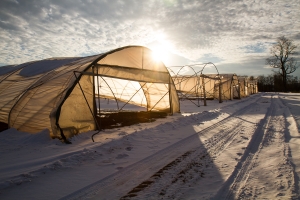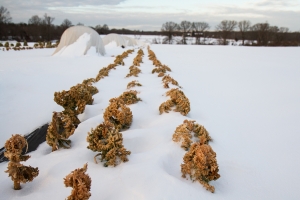The Season Grows Nigh: Planning for 2015
 Though spring may seem a long ways off, we at Blue Moon have already begun to prepare for the 2015 growing season. Planning begins as early as the summer, but ramps up in earnest around the winter solstice. From seed-sourcing to crop rotation-planning, there’s much to do in these cold months.
Though spring may seem a long ways off, we at Blue Moon have already begun to prepare for the 2015 growing season. Planning begins as early as the summer, but ramps up in earnest around the winter solstice. From seed-sourcing to crop rotation-planning, there’s much to do in these cold months.
As early as late summer, we begin by assigning cover crops to specific fields and plots. A good winter cover-crop—radish, rye, oats—protects the soil against erosion and ensures continuity of essential biological processes. With the arrival of consistent hard frost, we remove and compost residual summer and autumn crops. Mulch is applied to blueberries and other essential crops to prepare for the following spring. This ‘winterization’ is as much about protecting the fields from harsh winter elements as it is about clearing the way for the next year’s growing season.
Once the winterization is complete, we gather to review the previous season’s successes and failures, so as to be better prepared for the coming year. New crops are introduced; some are jettisoned. A large seed order is then placed—as early as possible, to ensure we get what we need. At this time too, we finalize our crop rotation plan. Crop rotation, planting different crops on different fields each year, hedges against soil nutrient depletion, ensuring a healthier, stronger, more disease-resistant plant. And finally, we purchase fertilizer and other components to add to our amazing compost.
 After the orders have been placed, we begin the seeding process. Early January sees the planting of cold-weather loving crops—kale, cauliflower, cabbage, and broccoli— in heated greenhouses. Come February, these seedings will be large enough to be transplanted into our high tunnels. And by the end of March, weather permitting, our first crop of baby lettuce heads will be ready to be harvested!
After the orders have been placed, we begin the seeding process. Early January sees the planting of cold-weather loving crops—kale, cauliflower, cabbage, and broccoli— in heated greenhouses. Come February, these seedings will be large enough to be transplanted into our high tunnels. And by the end of March, weather permitting, our first crop of baby lettuce heads will be ready to be harvested!
There’s always something to prepare for on the farm. Fortunately we have the winter to get it all done!
